Leaving on a Chocolatey High
It’s hard to believe that this is my last learning project post *tear*. Quite honestly, I didn’t realize this was the last week, so I whipped up another inclusion loaf. This time I tried chocolate chip. Let’s address the elephant in the room of acknowledge that my heart said to add waaaay too many chocolate chips. I think it’s more chocolate than bread at this point. I also messed up and added enough salt for two loaves, instead of one…. yeah, not great haha. I tried to salvage it, telling myself that it wasn’t so bad. But it really is. Don’t get me wrong, it’s tasty but its really salty. So as beautiful as she is, this one is headed to the trash cans. A picture doesn’t always tell the whole story.
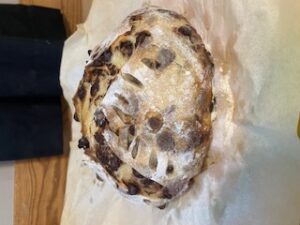
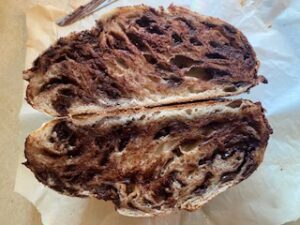
Extra salty loaf aside, it’s wild to think back 11 weeks ago and remember how unsure I was when I started this sourdough journey. But guess what?! I never got food poisoning! Hooray!! Here’s a recap of how we reached this monumental moment.
- Excitedly introduced my learning project.
- Blog post detailing the supplies I needed.
- I wrote in this original post, “I also have a sneaky suspicion I’m going to need a healthy dose of grace and patience…”. Oh, how right I was.
Week 2 – Getting my Gas in Gear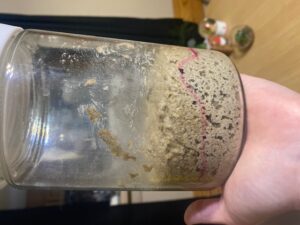
- Mixed my starter (Gerri) with rye flour.
- Sourdough starter video.
- Was encouraged by the growth I was seeing.
Week 3 – I was doing well…until I wasn’t
- Gerri died after I fed her bread flour instead of rye flour, and started to mold.
- Experimented with InShot to create a video of the feeding process.
- I thought Gerri 2.0 was ready to bake according to this article and this TikTok video.
- Followed a recipe from Little Spoon Farm to mix my bread dough, but then decided to mix in elements from Genevieve’s TikTok to complete the bread.
- I had very high hopes for this bread, but the starter just wasn’t strong enough to make a perfect loaf.
- The scoring on the loaf looked perfect! In that sense, it’s probably one of the best loaves I’ve made!
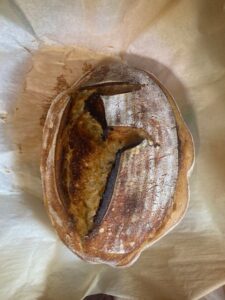 Week 6 – Confused and Discouraged
Week 6 – Confused and Discouraged
- I focused in on one dough recipe and technique and tried to make two loaves.
- I was getting very frustrated as was demonstrated by carving a giant F into one of the loaves.
- All signs (here, here, here, and here) were pointing to the fact that Gerri was never going to produce a respectable loaf of sourdough bread.
- I was very disheartened, but decided to start from scratch and make a new starter.
 Week 7 – Trash to Treasure: Discard English Muffins
Week 7 – Trash to Treasure: Discard English Muffins
- I had been storing discarded Gerri in the fridge for a while, so I decided to make the best of a disappointing situation and make some English muffins.
- Dave’s recipe and video tutorial was easy to follow and produced some tasty muffins!
- I finally had my first “win” of the project!
Week 8 – The moment you’ve all been waiting for!!!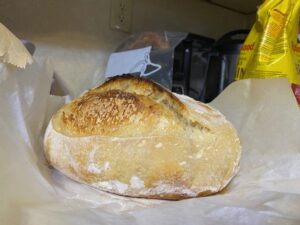
- I followed Gigi’s step-by-step guide to growing a sourdough starter, and Hermione was born!!
- Now that I had a strong starter, I was able to bake my first loaf of bread that actually rose!
- I talked through my learning this week in a vlog-style video.
Week 9 – You must be cheddar, because you’ve got me feeling extra cheesy today
- I finally started to feel confident in my ability to repeatedly produce a good loaf of sourdough bread.
- I decided to experiment with inclusions and make a cheddar loaf.
- This resource gave me an idea of how much cheese to use, and this resource helped me leaf how to work it into the dough.
- I created timelapse videos of how I formed the dough, and how I scored and baked it.
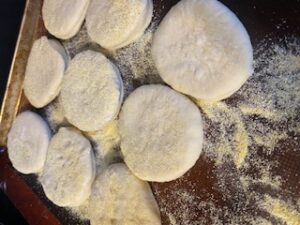 Week 10 – Discard or not discard, that is the question!
Week 10 – Discard or not discard, that is the question!
- I was curious if baking with active starter is always better than discard. So, I decided to try making English muffins with active starter.
- I created a timelapse video of the process of cooking the muffins.
- Ultimately decided that sometimes the simple route is the best route, at least where English muffins are concerned.
What did I learn during this project?
As I reflect on this project, I am coming to the realization that I learned more than I was expecting to. Not only about making sourdough but about learning online in general. Here are some of my key takeaways, in no particular order.
1. There is such a thing as too much information.
One of the amazing things about learning using online technology is the vast breadth and depth of information that is available. Anyone can learn anything they want to online. However, because there is no single right way to do something, sometimes too many cooks spoil the soup. Having too much information at my fingertips caused me to lose focus and likely affected by starter in the beginning.
2. A learning community improves learning.
Not only is it great to be able to learn from others online, but being able to discuss challenges and celebrate successes with a community of people who are interested in what you’re exploring, adds to the learning experience. I appreciated being able to keep up with others’ learning journeys and to learn through them. At the same time, I enjoyed seeing familiar names pop up in the comment section of my posts, as they followed along with my journey. The internet allows for the creation of these communities, regardless of where we are physically located, which is a remarkable thing.
3. Not all resources are created equal.
Part of this is knowing, or coming to understand, the way in which we each learn best, as individuals. I appreciate being able to see a demonstration of what I’m trying to learn, so I gravitate towards resources like YouTube and TikTok, and am less likely to utilize blog posts that have minimal visuals. It is also important to critically examine the resources we choose to learn from. How much content does this creator have on the subject? Do they have any formal qualifications? Are they the original creator of the content they are sharing? All of these questions help to direct learners towards resources that are the most beneficial.
4. Online learning is about more than resource collection.
I think it’s easy to fall into the trap of using technology solely as a tool to locate information and resources or mitigate the challenges of illegible penmanship. Using technology in the classroom allows for additional and extended learning opportunities. Students are able to demonstrate their understanding in ways that work best for them, as well as challenge them. Tech-based resources like coding allow for a deeper or broader understanding of topics and can act as a bridge between different areas of the curriculum. Being able to communicate with people and other students around the world means that classrooms are building their online learning communities, where they can share ideas, experiences, and learn with and from each other.
Well, I guess that’s everything for me. Thank you for following along on my learning journey and sharing in the successes, failures, and laughs along the way.
-Kendra
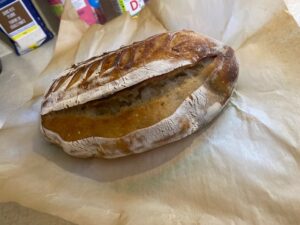 Week 5 – IT’S BAKING DAY!!!
Week 5 – IT’S BAKING DAY!!!